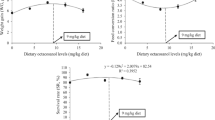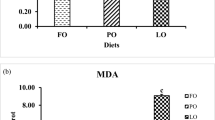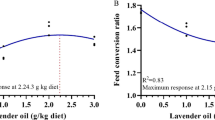Abstract
Whilst aquaculture feed is increasingly formulated with the inclusion of plant oils replacing fish oil, and increasing research effort has been invested in understanding the metabolic effects of reduced dietary n-3 long chain poly unsaturated fatty acids (n-3 LC-PUFA), relatively little information is available on the potential direct metabolic roles of dietary alpha-linolenic acid (ALA, 18:3n-3) and alpha-linolenic acid/linoleic acid (LNA, 18:2n-6) ratio in cultured marine finfish species. In this study, four plant oil based diets, with varying ALA/LNA ratio (0.0, 0.5, 1.0 and 1.5) were fed to juvenile large yellow croakers (Larimichthys crocea) and compared to a fish oil-based control diet (CD) to evaluate the resulting effects on growth, nonspecific immunity, anti-oxidant capacity and related gene expression. High dietary LNA negatively impacted fish growth performance, nonspecific immunity and antioxidant capacity, but growth and immunity were maintained to levels comparable to CD by increasing the ratio of dietary ALA/LNA. The over-expression of genes associated with inflammation (cyclooxygenase-2 and interleukin-1β) and fatty acid oxidation (carnitine palmitoyl transferase I and acyl CoA oxidase) in croakers fed high concentrations of LNA were reduced to levels comparable to those fed CD by increasing dietary ALA/LNA. This study showed that dietary ALA, by increasing the overall n-3/n-6 PUFA ratio, exerts direct anti-inflammatory and antioxidant effects, similar to those exerted by dietary n-3 LC-PUFA.



Similar content being viewed by others
Abbreviations
- ALA:
-
Alpha-linolenic acid
- ACO:
-
Acyl CoA oxidase
- CAT:
-
Catalase
- COX-2:
-
Cyclooxygenase-2
- CPTI:
-
Carnitine palmitoyl transferase I
- FAS:
-
Fatty acid synthase
- G6PD:
-
6-Phosphogluconate dehydrogenase
- HSI:
-
Hepatosomatic index
- LNA:
-
Linoleic acid
- MDA:
-
Malondialdehyde
- ME:
-
Malic enzyme
- PI:
-
Phagocytic index
- SOD:
-
Superoxide dismutase
- T-AOC:
-
Total antioxidant capacity
- VSI:
-
Viscerosomatic index
References
Turchini GM, Torstensen BE, Ng WK (2009) Fish oil replacement in finfish nutrition. Rev Aquacult 1:10–57
Tacon Metian (2008) Global overview on the use of fish meal and fish oil in industrially compounded aquafeeds: trends and future prospects. Aquaculture 285:146–158
Olsen Y (2011) Resources for fish feed in future mariculture. Aquacult Environ Interact 1:187–200
Hardy RW, Scott TM, Harrell LW (1987) Replacement of herring oil with menhaden oil, soybean oil, or tallow in the diets of Atlantic salmon raised in marine net-pens. Aquaculture 65:267–277
Bell JG, McEvoy J, Tocher DR, McGhee F, Campbell PJ, Sargent JR (2001) Replacement of fish oil with rapeseed oil in diets of Atlantic salmon (Salmo salar) affects tissue lipid compositions and hepatocyte fatty acid metabolism. J Nutr 131:1535–1543
Bell JG, Henderson RJ, Tocher DR, McGhee F, Dick JR, Porter A, Smullen RP, Sargent JR (2002) Substituting fish oil with crude palm oil in the diet of Atlantic salmon (Salmo salar) affects muscle fatty acid composition and hepatic fatty acid metabolism. J Nutr 132:222–230
Bell JG, Tocher DR, Henderson RJ, Dick JR, Crampton VO (2003) Altered fatty acid compositions in Atlantic salmon (Salmo salar) fed diets containing linseed and rapeseed oils can be partially restored by a subsequent fish oil finishing diet. J Nutr 133:2793–2801
Bell JG, Henderson RJ, Tocher DR, Sargent JR (2004) Replacement of dietary fish oil with increasing levels of linseed oil: modification of flesh fatty acid compositions in Atlantic salmon (Salmo salar) using a fish oil finishing diet. Lipids 39:223–232
Torstensen BE, Bell JG, Rosenlund G, Henderson RG, Graff IE, Tocher DR, Lie Ø, Sargent JR (2005) Tailoring of Atlantic salmon (Salmo salar L.) flesh lipid composition and sensory quality by replacing fish oil with a vegetable oil blend. J Agric Food Chem 53:10166–10178
Richard N, Kaushik S, Larroquet L, Panserat S, Corraze G (2006) Replacing dietary fish oil by vegetable oils has little effect on lipogenesis, lipid transport and tissue lipid uptake in rainbow trout (Oncorhynchus mykiss). Brit J Nutr 96:299–309
Thanuthong T, Francis DS, Senadheera SD, Jones PL, Turchini GM (2011) Fish oil replacement in rainbow trout diets and total dietary PUFA content: I) Effects on feed efficiency, fat deposition and the efficiency of a finishing strategy. Aquaculture 320:82–90
Thanuthong T, Francis DS, Manickam E, Senadheera SD, Cameron-Smith D, Turchini GM (2011) Fish oil replacement in rainbow trout diets and total dietary PUFA content: II) Effects on fatty acid metabolism and in vivo fatty acid bioconversion. Aquaculture 322–323:99–108
Montero D, Kalinowski T, Obach A, Robaina L, Tort L, Caballero MJ, Izquierdo MS (2003) Vegetable lipid sources for gilthead seabream (Sparus aurata): effects on fish health. Aquaculture 225:353–370
Montero D, Robaina L, Caballero MJ, Ginés R, Izquierdo MS (2005) Growth, feed utilization and flesh quality of European sea bass (Dicentrarchus labrax) fed diets containing vegetable oils: a time-course study on the effect of a re-feeding period with a 100 % fish oil diet. Aquaculture 248:121–134
Menoyo D, Izquierdo MS, Robaina L, Ginés R, Lopez-Bote CJ (2004) Adaptation of lipid metabolism, tissue composition and flesh quality in gilthead sea bream (Sparus aurata) to the replacement of dietary fish oil by linseed and soyabean oils. Brit J Nutr 92:41–52
Izquierdo MS, Montero D, Robaina L, Caballero MJ, Rosenlund G, Ginésa R (2005) Alterations in fillet fatty acid profile and flesh quality in gilthead seabream (Sparus aurata) fed vegetable oils for a long term period. Recovery of fatty acid profiles by fish oil feeding. Aquaculture 250:431–444
Benedito-Palos L, Navarro JC, Kaushik S, Pérez-Sánchez J (2010) Tissue-specific robustness of fatty acid signatures in cultured gilthead sea bream (Sparus aurata L.) fed practical diets with a combined high replacement of fish meal and fish oil. J Anim Sci 88:1759–1770
Sargent JR, Tocher DR, Bell JG (2002) The lipids. In: Halver JE, Hardy RW (eds) Fish Nutrition. Academic Press, Elsevier, San Diego, pp 181–257
Yu TC, Sinnhuber RO (1976) Growth response of rainbow trout (Salmo gairdneri) to dietary ω3 and ω6 fatty acids. Aquaculture 8:309–317
Yu TC, Sinnhuber RO (1979) Effects of dietary ω3 and ω6 fatty acids on growth and feed conversion efficiency of coho salmon (Oncorhynchus kisutch). Aquaculture 16:31–38
Peng SM, Chen LQ, Qin JG, Hou JL, Yu N, Long ZQ, Ye JY, Sun XJ (2008) Effects of replacement of dietary fish oil by soybean oil on growth performance and liver biochemical composition in juvenile black seabream, Acanthopagrus schlegeli. Aquaculture 276:154–161
Montero D, Grasso V, Izquierdo MS, Ganga R, Real F, Tort L, Caballero MJ, Acosta F (2008) Total substitution of fish oil by vegetable oils in gilthead sea bream (Sparus aurata) diets: effects on hepatic Mx expression and some immune parameters. Fish Shellfish Immunol 24:147–155
Montero D, Mathlouthi F, Tort L, Afonso JM, Torrecillas S, Fernández-Vaquero A, Negrin D, Izquierdo MS (2010) Replacement of dietary fish oil by vegetable oils affects humoral immunity and expression of proinflammatory cytokines genes in gilthead sea bream Sparus aurata. Fish Shellfish Immunol 29:1073–1081
Thompson KD, Tatner MF, Henderson RJ (1996) Effects of dietary (n-3) and (n-6) polyunsaturated fatty acid ratio on the immune response of Atlantic salmon, Salmo salar L. Aquacult Nutr 2:21–31
Wu FC, Chen HY (2012) Effects of dietary linolenic acid to linoleic acid ratio on growth, tissue fatty acid profile and immune response of the juvenile grouper Epinephelus malabaricus. Aquaculture 324–325:111–117
Zuo RT, Ai QH, Mai KS, Xu W (2013) Effects of conjugated linoleic acid (CLA) on growth, nonspecific immunity, antioxidant capacity, lipid deposition and related gene expression in juvenile large yellow croaker (Larimichthys crocea) fed soybean oil based diets. Brit J Nutr 110:1220–1232
Liang MQ, Lu QK, Qian C, Zheng KK, Wang XX (2014) Effects of dietary n-3 to n-6 fatty acid ratios on spawning performance and larval quality in tongue sole Cynoglossus semilaevis. Aquacult Nutr 20:79–89
Xu XL, Ji W, Castell JD, O’Dor R (1993) The nutritional value of dietary n-3 and n-6 fatty acid for the Chinese prawn (Penaeus chinensis). Aquaculture 118:277–285
Glencross BD, Smith DM, Thomas MR, Williams KC (2002) The effect of n-3 and n-6 fatty acid balance on the growth of the prawn Penaeus monodon. Aquacult Nutr 8:43–51
Robaina L, Izquierdo MS, Moyano FJ, Socorro J, Vergara JM, Montero D (1998) Increase of the dietary n-3/n-6 fatty acid ratio and addition of phosphorus improves liver histological alterations induced by feeding diets containing soybean meal to gilthead seabream, Sparus aurata. Aquaculture 161:281–293
Berge GM, Witten PE, Baeverfjord G, Vegusdal A, Wadsworth S, Ruyter B (2009) Diets with different n-6/n-3 fatty acid ratio in diets for juvenile Atlantic salmon, effects on growth, body composition, bone development and eicosanoid production. Aquaculture 296:299–308
Rollin X, Peng JL, Pham D, Ackman RG, Larondelle Y (2003) The effects of dietary lipid and strain difference on polyunsaturated fatty acid composition and conversion in anadromous and landlocked salmon (Salmo salar L.) parr. Comp Biochem Phys 134B:349–366
Menoyo D, Lopez-Bote CJ, Diez A, Obach A, Bautista JM (2007) Impact of n-3 fatty acid chain length and n-3/n-6 ratio in Atlantic salmon (Salmo salar) diets. Aquaculture 267:248–259
Tan XY, Luo Z, Xie P, Liu XX (2009) Effect of dietary linolenic acid/linoleic acid ratio on growth performance, hepatic fatty acid profiles and intermediary metabolism of juvenile yellow catfish Pelteobagrus fulvidraco. Aquaculture 310:186–191
Chen CY, Sun BL, Li XX, Li PY, Guan WT, Bi YZ, Pan Q (2013) N-3 essential fatty acids in Nile tilapia, Oreochromis niloticus: quantification of optimum requirement of dietary linolenic acid in juvenile fish. Aquaculture 416–417:99–104
Blanchard G, Makombu JG, Kesternont P (2008) Influence of different dietary 18: 3n-3/18:2n-6 ratio on growth performance, fatty acid composition and hepatic ultrastructure in Eurasian perch, Perca fluviatilis. Aquaculture 284:144–150
Senadheera SPSD, Turchini GM, Thanuthong T, Francis DS (2010) Effects of dietary α-linolenic acid (18:3n-3)/linoleic acid (18:2n-6) ratio on growth performance, fillet fatty acid profile and finishing efficiency in Murray cod. Aquaculture 309:222–230
Weaver KL, Ivester P, Seeds M, Case LD, Arm JP, Chilton FH (2009) Effect of dietary fatty acids on inflammatory gene expression in healthy humans. J Biol Chem 284:15400–15407
Glencross BD (2009) Exploring the nutritional demand for essential fatty acids by aquaculture species. Rev Aquacult 204:89–99
Kelley DS (2001) Modulation of human immune and inflammatory responses by dietary fatty acids. Nutrition 17:669–673
Ai QH, Mai KS, Tan BP, Xu W, Zhang WB, Ma HM, Liufu ZG (2006) Effects of dietary vitamin C on survival, growth and immunity of large yellow croaker, Pseudosciaena crocea. Aquaculture 261:327–336
Ai QH, Mai KS, Zhang L, Tan BP, Zhang WB, Xu W, Li HT (2007) Effects of dietary β-1, 3 glucan on innate immune response of large yellow croaker, Pseudosciaena crocea. Fish Shellfish Immunol 22:394–402
Ai QH, Zhao JZ, Mai KS, Xu W, Tan BP, Ma HM, Liufu ZG (2008) Optimal dietary lipid level for large yellow croaker (Pseudosciaena crocea) larvae. Aquacult Nutr 14:515–522
Wang J, Ai QH, Mai KS, Xu W, Xu HG, Zhang WB, Wang XJ, Liufu ZG (2010) Effects of dietary ethoxyquin on growth performance and body composition of large yellow croaker Pseudosciaena crocea. Aquaculture 306:80–84
Zuo RT, Ai QH, Mai KS, Xu W, Wang J, Liufu ZG, Zhang YJ (2012) Effects of dietary n-3 highly unsaturated fatty acids on growth, nonspecific immunity, expression of some immune related genes and disease resistance of large yellow croaker (Larimichthys crocea) following natural infestation of parasites (Cryptocaryon irritans). Fish Shellfish Immunol 32:249–258
Metcalfe LD, Schmitz AA, Pelka JR (1966) Rapid preparation of fatty acid esters from lipids for gas chromatographic analysis. Anal Chem 38:514–515
Ackman RG (2002) The gas chromatograph in practical analyses of common and uncommon fatty acids for the 21st century. Anal Chim Acta 465:175–192
Pulsford AL, Crampe M, Langston A, Glynn PG (1995) Modulatory effects of disease, stress, copper, TBT and vitamin E on the immune system of flatfish. Fish Shellfish Immunol 5:631–643
Secombes CJ (1990) Isolation of salmonid macrophages and analysis of their killing activity. In: Stolen JS, Fletcher TC, Anderson DP, Robertsen BS, Van Muiswinkel WB (eds) Techniques in fish immunology. SOS Publications, Fair Haven NJ, pp 137–154
Ellis AE (1990) Lysozyme assays. In: Stolen JS, Fletcher TC, Anderson DP, Robertsen BS, Van Muiswinkel WB (eds) Techniques in fish immunology. SOS Publications, Fair Haven NJ, pp 101–103
Bradford M (1976) A rapid sensitive method for the quantitation of microgram quantities of protein utilizing the principle of protein–dye binding. Anal Biochem 72:248–254
McCord JM, Fridovich I (1969) Superoxide dismutase: an enzymatic function for erythrocuprein. J Biol Chem 244:6049–6055
Aebi H (1984) Catalase ‘‘in vitro’’. Methods Enzymol 105:121–127
Gavino VC, Miller JS, Ikharebha SO, Milo GE, Cornwell DG (1981) Effects of polyunsaturated fatty acids and antioxidants on lipid peroxidation in tissue cultures. J Lipid Res 22:763–769
Yao CL, Kong P, Wang ZY, Ji PF, Cai MY, Liu XD, Han XZ (2009) Molecular cloning and expression of MyD88 in large yellow croaker, Pseudosciaena crocea. Fish Shellfish Immunol 26:249–255
Zhao ZY, Wu TX, Tang HG, Pan XD, Zhang JZ (2008) Effect of conjugated Linoleic acid on growth, lipid metabolism and liver peroxisome proliferators-activated receptor expression of large yellow croaker (Pseudosciaena crocea). J Food Lipids 15:534–554
Kanazawa A, Teshima S, Ono K (1979) Relationship between essential fatty acid requirements of aquatic animals and the capacity for bioconversion of linolenic acid to highly unsaturated fatty acids. Comp Biochem Physiol 63B:295–298
Watanabe T (1982) Lipid nutrition in fish. Comp Biochem Physiol 73B:3–15
Richard N, Mourente G, Kaushik S, Corraze G (2006) Replacement of a large portion of fish oil by vegetable oils does not affect lipogenesis, lipid transport and tissue lipid uptake in European seabass (Dicentrarchus labrax L.). Aquaculture 261:1077–1087
Peng M, Xu W, Mai KS, Zhou HH, Zhang YJ, Liufu ZG, Zhang KK, Ai QH (2014) Growth performance, lipid deposition and hepatic lipid metabolism related gene expression in juvenile turbot (Scophthalmus maximus L.) fed diets with various fish oil substitution levels by soybean oil. Aquaculture 433:442–449
Chen YX, Varghese Z, Ruan XZ (2014) The molecular pathogenic role of inflammatory stress in dysregulation of lipid homeostasis and hepatic steatosis. Genes Dis 1:106–112
Madsen L, Rustan AC, Vaagenes H, Berge K, Dyrøy E, Berge RK (1999) Eicosapentaenoic and docosahexaenoic acid affect mitochondrial and peroxisomal fatty acid oxidation in relation to substrate preference. Lipids 34:951–963
Park HJ, Park JS, Hayek MJ, Reinhart GA, Chew BP (2011) Dietary fish oil and flaxseed oil suppress inflammation and immunity in cats. Vet Immunol Immunop 141:301–306
Calder PC (2003) n-3 polyunsaturated fatty acids and inflammation: from molecular biology to the clinic. Lipids 38:343–352
Farndale BM, Bell JG, Bruce MP, Bromage NR, Oyen F, Zanuy S, Sargent JR (1999) Dietary lipid composition affects blood leucocyte fatty acid compositions and plasma eicosanoid concentrations in European sea bass (Dicentrarchus labrax). Aquaculture 179:335–350
Ganga R, Bell JG, Montero D, Robaina L, Caballero MJ, Izquierdo MS (2005) Effect of dietary lipids on plasma fatty acid profiles and prostaglandin and leptin production in gilthead seabream (Sparus aurata). Comp Biochem Physiol 142B(410–418):62
McGuire SO, Alexander DW, Fritsche KL (1997) Fish oil source differentially affects rat immune cell alpha-tocopherol concentration. J Nutr 127:1388–1394
Wu D, Meydani SN, Meydani M, Hayek MG, Huth P, Nicolosi RJ (1996) Immunologic effects of marine- and plant-derived n-3 polyunsaturated fatty acids in nonhuman primates. Am J Clin Nutr 63:273–280
Priyamvada S, Khan SA, Khan MW, Khan S, Farooq N, Khan F, Yusufi ANK (2010) Studies on the protective effect of dietary fish oil on uranyl-nitrate-induced nephrotoxicity and oxidative damage in rat kidney. Prostag Leukotr Ess 82:35–44
Tsuduki T, Honma T, Nakagawa K, Ikeda I, Miyazawa T (2011) Long-term intake of fish oil increases oxidative stress and decreases lifespan in senescence-accelerated mice. Nutrition 27:334–337
Trenzado CE, Morales AE, Palma JM, Higuera MDL (2009) Blood antioxidant defenses and hematological adjustments in crowded/uncrowded rainbow trout (Oncorhynchus mykiss) fed on diets with different levels of antioxidant vitamins and LC-PUFA. Comp Biochem Phys 149C:440–447
Acknowledgments
This research was supported by the National Natural Foundation of China (Grant No.: 30871930, 31172425). We thank H. Asino, Q.Y. Duan, J.K. Shentu, Y.F. Zheng, X.J. Dong and P. Tan for their help during the experiment. We greatly appreciated the editors and three anonymous reviewers for their constructive comments in improving the quality of this manuscript.
Author information
Authors and Affiliations
Corresponding author
About this article
Cite this article
Zuo, R., Mai, K., Xu, W. et al. Dietary ALA, But not LNA, Increase Growth, Reduce Inflammatory Processes, and Increase Anti-Oxidant Capacity in the Marine Finfish Larimichthys crocea . Lipids 50, 149–163 (2015). https://doi.org/10.1007/s11745-014-3970-z
Received:
Accepted:
Published:
Issue Date:
DOI: https://doi.org/10.1007/s11745-014-3970-z




